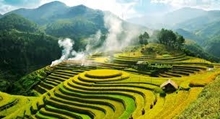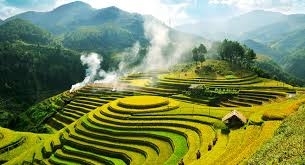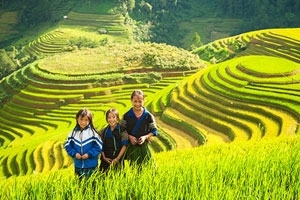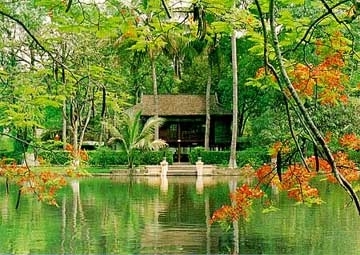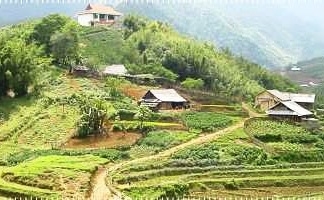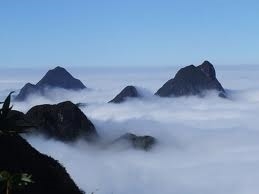Quick facts:
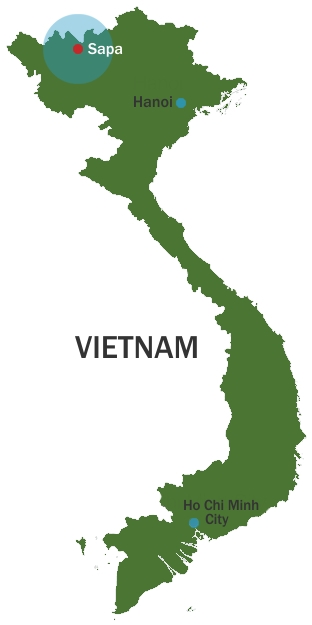
Location: Lao Cai Province
Area: 700 km2
Elevation: 1600m
Population: 53.549 (2009)
Highest peak: Mount Fansipan (3142m)
Major ethnic minority groups: H’mong, Dao, Tay, Giay, Xa Pho
Highlights: terraced rice fields, ethnic markets, ethnic homestay, trekking
Introduction:
Sapa is a frontier town in Lao Cai Province in north west Vietnam, about 380 km from Hanoi, close to the China border. Sapa first appeared in the national map in the late 1880s when the French disembarked in highland Tonkin. The first French arrived in Sapa in 1909, and by 1920, there were a number of villas built in this area by several wealthy people. Going through many ups and downs, Sapa nowadays becomes the premier holiday destination for both locals and foreigners.
The town has the most of the spectacular views emerging on clear days. In cloudy days, it is often shrouded by thick mist rolling across the mountains, but even that, Sapa is still a fascinating destination, especially when local hill tribes fill the streets with vivid color of their costumes.
There is nowhere in Vietnam that you can easily see local ethnic minorities like in Sapa. The town is home of a great diversity of ethnic people, including Hmong, Dao (Yao), Pho Lu, as well as a smaller number of Tay and Giay. Most of them live in small villages in modest huts and hamlets scattered throughout the region. Sapa town is the place where they come to gather, buy or selling goods like corn, rice, handicrafts and souvenir to tourists. A surprise and interesting fact for many visitors here is that lots of ethnic minority people in Sapa, especially children, can speak English very well in spite of not attending any school.
When to go
At the height of 1,600m about the sea level, the average temperature is 15-18°C. The climate is moderate and cool in the summer, wet from May to September and foggy and cold in winter (November to February). Visitors to Sapa in summer can witness four seasons in one day. Morning and afternoon, it is cool like the weather in spring and autumn. At noon, it’s sunny with a cloudless sky. And the weather turns into cold in the evening. A thunderstorm short and rains may come on any summer day.
Sapa is a year-round destination with its own charm in each season. Best time to go depends on what you want to see. Sapa is perhaps most beautiful in spring when it is blooming with many kinds of flower like apricot, plum and cherry. For many people, the best time to come is between May and September, also the rainy season, when the rice paddies are green. The winter is very cold, the temperature can drop below zero and there might be snow, a rare marvel of nature in a country of tropical climate like Vietnam. The view of Sapa’s rice terraces is best seen between September to October when the weather is cool and the harvest season comes to town.
Getting there
By road: The newly opened highway linking Hanoi and Lao Cai province provides a more convenient and faster way to Sapa as it cuts in half the travel time to 4 – 5 hours instead of 8 hours as before.
By overnight train: Take an overnight train is a traditional way that’s safer than a bus or motorbike, and cheaper than hiring a car. There are sleeper trains leave Hanoi Railway Station each evening. It will take around 8 hours to reach Lao Cai. Then you continue by car about 30km to Sapa. Normally, trains have three types of cabins: 4-berth, 6-berth and soft-seat cabins. There are also daytime trains depart in the morning and arrive in the afternoon, but it is not recommended as they make many stops along the way.
By motorbike: This kind of transport is for backpackers and adventurous travelers. There are two main routes to get Sapa from Hanoi: via Lao Cai or take the direction of Lai Chau. While the former is quite easy, the latter is a little challenging as you have to conquer 2 of 4 legendary mountain passes in the Northwestern Vietnam, the 30km Khau Pha pass and O Quy Ho, Vietnam’s longest pass of 50km. However, traveling by motorbike gives you the freedom as you can stop to rest anytime and enjoy the stunning scenery along the way that other ways of travel cannot offer.
Top things to do and see:
Cat Cat Village: One of the most popular attractions in town located within easy walking distance from the center. The village was established in the 19th century by the gathering of some ethnic families in the mountainous areas, especially the Black H’mong. Visiting Cat Cat, tourists will be impressed by the peaceful sceneries of women sitting in front of the loom with colorful pieces of brocade, while children playing around with pets or even livestock. Moreover, the village is also famous for manipulating sophisticated gold and silver jewelries.
Ta Phin Village: Located about 17km in the west of Sapa, Ta Phin is home to Red Dao and H’mong ethnic minorities living side by side for hundreds of years but still retain their own tradition and cultures. Stroll around the village, enjoy the picturesque landscape of rice fields, mountains, streams and hill tribe houses, you will learn the differences between these tribal communities. Ta Phin is also known as the brocade village where visitors can find distinctively hand-made brocades made by locals.
Bac Ha market: Bac Ha market takes place every Sunday and is the biggest ethnic market in Northwest Vietnam, attracting throngs of local people from the surrounding hill tribes. Some have to walk several hours for the weekly opportunity to buy and sell goods and homemade products. Yet the distance has never discouraged them from joining this Sunday colorful market. It is also considered a place for people to meet, for women to demonstrate their colorful traditional costumes, for the young to find their dates. The market is not only a draw for locals, it’s a big hit with travelers too. Bac Ha Market is really a feast for the eyes!
Ham Rong Mountain: Stand at 1,850 meters high, Ham Rong Mountain peak rises as dragon-head in the sky. From here, visitors can see the stunning sunset paint of brilliant hues with the below town and valley as the background. You will also catch beautiful views of the Indochina rooftop, Mt. Fansipan in sunny days. Ham Rong Mountain is actually located in the same name flower park with beautiful landscaped gardens of numerous kinds of orchids and flowers. Only a short walk from Sapa church, it is best visited in spring, when all flowers in blossom, boast their beauty and perfume.
Climbing Fansipan Mountain: At the height of 3,143m, Fansipan has been widely known as the highest peak in Vietnam. Conquering the summit often takes around 2 days with one night spending in tents or bamboo huts located at 2,200m. One-day trek is also possible if you are well fit. With the newly-opened cable car system, visitors now can reach the summit within 15 minutes instead of two day challenging trek before.
Trekking: Sapa is voted as one of Vietnam’s best trekking destinations, flavored by both natives and foreigners. Though you can see the beauty of Sapa from an AC vehicle, it’s only when hike through rice terraced fields, forest and visit remote villages of ethnic minorities that you will really experience all that this region has to offer. The scenery of Sapa reflects the harmony between people and nature. You can see it in the many rice fields carpeting the rolling slopes of the Hoang Lien Mountain.
You can trek to Lao Chai, Ta Van, Giang Ta Chai, Ban Ho or the Silver Waterfall, it depends on the time you have, where you want to go and how active you are.
Ethnic markets: In Sapa, ethnic market is not all about Bac Ha. There are many other authentic markets for you to choose from.
• Coc Ly market on Tuesday is colored by the distinctive and bright costumes of the Flower H’mong ethnicity. This market is about 35km from Bac Ha.
• Xin Cheng market opens on every Wednesdays, a gathering point of many local minorities such as Flower Hmong, Tay and Giay.
• Lung Khau Nhin market taking place every Thursday. A small market hides itself among the mountains and forests of the far north. It still keeps many original characters.
• Can Cau market is one of Vietnam’s most fascinating open air markets which takes place only on Saturday every week. This is a bustling local market still retains the local quaint and authentic. It is about 130km from Sapa
• Lung Phin Market: this small market opens on Sunday and about 120km from Sapa.
• Binh Lu & Tam Duong Market (Every Sunday) is located on the other side of Sapa past Tram Ton Pass.
Where to eat:
Another reason draws visitors to Sapa is its specialties. The cool weather makes barbecued meat and fish with mushroom and sub-tropical vegetables like white cauliflower, red beet, and chayote the most favorite street foods in Sapa. Some must try dishes includes oiled chayote consumed with sesame or “lon cap nach”- pig carried under armpit, which are home pigs but are raised in the field or forest. You can also try many other local dishes such as purple sticky rice, “thang co”, a horse meat soup in many markets. Western restaurant can be found around the center of the town with a very affordable price.
Red Dao House
Address: 4B Thac Bac St, Sapa
This smart restaurant has a nice front terrace with unique design resembling a hill-tribe house and the staff wearing traditional Dao costumes. . This is one of the best restaurants in town serving both Vietnamese and Western menu. Local specialties like pan fried prawn with garlic, honey-roasted duck, steak with mushroom sauce, and chicken hot pot are also available.
The Gecko Restaurant
Address: 4 Ham Rong St, Sapa
Located in the center of the town, Le Gecko has a well-established reputation for its French cuisine. The Le Gecko itself includes a hotel, a restaurant and a bar. The restaurant is wooden traditional H'mong house with Black H'mong decoration. Pizza, sandwiches and pasta are among the most favorite dishes. With view over Sapa Park, this place is a great choice for people watch daily life while enjoy their meal.
Buffalo Bell Restaurant
Address: 25 Cau May, Sapa
Located at the busiest street in Sapa, Buffalo Bell Restaurant can accommodate up to 60 guests. It serves traditional home style cooked dishes with international ones. The restaurant also has an outdoor terrace bar, makes it a perfect setting for relax and hang out after exploring the town.
The Hill Station Signature Restaurant
Address: 37 Fansipan St
Situated right at the corner of Fansipan St., this new restaurant offers a diverse menu coming with a wide list of wine. Specializing in the food of the ethnic minorities in the region combining with Danish design sensibility with local touches and view of the town and mountain.
Lucky Daisy's Bamboo Bar + Restaurant
Address: Ta Van village, Muong Hoa valley, Sapa
A 30 minute drive will take you to the restaurant sets amid stunning mountain and rice terraces in Ta Van village. It's also a bar and pub. In fact, it is not mainly a public restaurant, guests are served for the night with Sapa local dinners. Eddie and Hien, the owners, are very helpful and considerable hosts to make your stay comfortable and memorable.
The Northwest
Dien Bien Phu
 Dien Bien was the scene of the siege in 1954 that once was the battlefield where historical combats between the Vietnamese People Army and the French Colonialists Expeditionary Corp took place. The victory after 55 days and nights of an extremely heroic struggle finally ended French colonialism in Indochina.
Dien Bien was the scene of the siege in 1954 that once was the battlefield where historical combats between the Vietnamese People Army and the French Colonialists Expeditionary Corp took place. The victory after 55 days and nights of an extremely heroic struggle finally ended French colonialism in Indochina.
Besides visiting the Dien Bien Phu museum, Him Lim hill, the underground shelter of the French commanding General De Castre. Dien Bien Phu now bears few scars except for the occasional scattered tank to bear witness to its horrendous past, though it is still one of the remotest areas you could visit. You can also visit the Thai minority people in the nearby villages. The hill tribes living around the area of Dien Bien Phu include the Black Thai, Nung, Meo, Lao and others.
Mai Chau
 About 4 hours drive (180 Km NW) from Hanoi, 80 km from Hoa Binh, Mai Chau is a peaceful town where settling the Thai ethnic group. The scenery between Hoa Binh and Mai Chau is truly spectacular. you will also pass through valleys still packed with awesome old growth forest and through villages inhabited by hill tribe people. Mai Chau, nestled in a lush valley and surrounded by emerald green paddies, is enchanting to look at when you are driving over the mountain pass. At Mai Chau, visitors can have the opportunity to experience living with the White Thai minorities for one night in their clean and well-kept house on stilts. Sharing the special "Can wine" during dinner with the host will be an unforgettable experience.
About 4 hours drive (180 Km NW) from Hanoi, 80 km from Hoa Binh, Mai Chau is a peaceful town where settling the Thai ethnic group. The scenery between Hoa Binh and Mai Chau is truly spectacular. you will also pass through valleys still packed with awesome old growth forest and through villages inhabited by hill tribe people. Mai Chau, nestled in a lush valley and surrounded by emerald green paddies, is enchanting to look at when you are driving over the mountain pass. At Mai Chau, visitors can have the opportunity to experience living with the White Thai minorities for one night in their clean and well-kept house on stilts. Sharing the special "Can wine" during dinner with the host will be an unforgettable experience.
Sapa & The Northwest
Quick facts:

Location: Lao Cai Province
Area: 700 km2
Elevation: 1600m
Population: 53.549 (2009)
Highest peak: Mount Fansipan (3142m)
Major ethnic minority groups: H’mong, Dao, Tay, Giay, Xa Pho
Highlights: terraced rice fields, ethnic markets, ethnic homestay, trekking
Introduction:
Sapa is a frontier town in Lao Cai Province in north west Vietnam, about 380 km from Hanoi, close to the China border. Sapa first appeared in the national map in the late 1880s when the French disembarked in highland Tonkin. The first French arrived in Sapa in 1909, and by 1920, there were a number of villas built in this area by several wealthy people. Going through many ups and downs, Sapa nowadays becomes the premier holiday destination for both locals and foreigners.
The town has the most of the spectacular views emerging on clear days. In cloudy days, it is often shrouded by thick mist rolling across the mountains, but even that, Sapa is still a fascinating destination, especially when local hill tribes fill the streets with vivid color of their costumes.
There is nowhere in Vietnam that you can easily see local ethnic minorities like in Sapa. The town is home of a great diversity of ethnic people, including Hmong, Dao (Yao), Pho Lu, as well as a smaller number of Tay and Giay. Most of them live in small villages in modest huts and hamlets scattered throughout the region. Sapa town is the place where they come to gather, buy or selling goods like corn, rice, handicrafts and souvenir to tourists. A surprise and interesting fact for many visitors here is that lots of ethnic minority people in Sapa, especially children, can speak English very well in spite of not attending any school.
When to go
At the height of 1,600m about the sea level, the average temperature is 15-18°C. The climate is moderate and cool in the summer, wet from May to September and foggy and cold in winter (November to February). Visitors to Sapa in summer can witness four seasons in one day. Morning and afternoon, it is cool like the weather in spring and autumn. At noon, it’s sunny with a cloudless sky. And the weather turns into cold in the evening. A thunderstorm short and rains may come on any summer day.
Sapa is a year-round destination with its own charm in each season. Best time to go depends on what you want to see. Sapa is perhaps most beautiful in spring when it is blooming with many kinds of flower like apricot, plum and cherry. For many people, the best time to come is between May and September, also the rainy season, when the rice paddies are green. The winter is very cold, the temperature can drop below zero and there might be snow, a rare marvel of nature in a country of tropical climate like Vietnam. The view of Sapa’s rice terraces is best seen between September to October when the weather is cool and the harvest season comes to town.
Getting there
By road: The newly opened highway linking Hanoi and Lao Cai province provides a more convenient and faster way to Sapa as it cuts in half the travel time to 4 – 5 hours instead of 8 hours as before.
By overnight train: Take an overnight train is a traditional way that’s safer than a bus or motorbike, and cheaper than hiring a car. There are sleeper trains leave Hanoi Railway Station each evening. It will take around 8 hours to reach Lao Cai. Then you continue by car about 30km to Sapa. Normally, trains have three types of cabins: 4-berth, 6-berth and soft-seat cabins. There are also daytime trains depart in the morning and arrive in the afternoon, but it is not recommended as they make many stops along the way.
By motorbike: This kind of transport is for backpackers and adventurous travelers. There are two main routes to get Sapa from Hanoi: via Lao Cai or take the direction of Lai Chau. While the former is quite easy, the latter is a little challenging as you have to conquer 2 of 4 legendary mountain passes in the Northwestern Vietnam, the 30km Khau Pha pass and O Quy Ho, Vietnam’s longest pass of 50km. However, traveling by motorbike gives you the freedom as you can stop to rest anytime and enjoy the stunning scenery along the way that other ways of travel cannot offer.
Top things to do and see:
Cat Cat Village: One of the most popular attractions in town located within easy walking distance from the center. The village was established in the 19th century by the gathering of some ethnic families in the mountainous areas, especially the Black H’mong. Visiting Cat Cat, tourists will be impressed by the peaceful sceneries of women sitting in front of the loom with colorful pieces of brocade, while children playing around with pets or even livestock. Moreover, the village is also famous for manipulating sophisticated gold and silver jewelries.
Ta Phin Village: Located about 17km in the west of Sapa, Ta Phin is home to Red Dao and H’mong ethnic minorities living side by side for hundreds of years but still retain their own tradition and cultures. Stroll around the village, enjoy the picturesque landscape of rice fields, mountains, streams and hill tribe houses, you will learn the differences between these tribal communities. Ta Phin is also known as the brocade village where visitors can find distinctively hand-made brocades made by locals.
Bac Ha market: Bac Ha market takes place every Sunday and is the biggest ethnic market in Northwest Vietnam, attracting throngs of local people from the surrounding hill tribes. Some have to walk several hours for the weekly opportunity to buy and sell goods and homemade products. Yet the distance has never discouraged them from joining this Sunday colorful market. It is also considered a place for people to meet, for women to demonstrate their colorful traditional costumes, for the young to find their dates. The market is not only a draw for locals, it’s a big hit with travelers too. Bac Ha Market is really a feast for the eyes!
Ham Rong Mountain: Stand at 1,850 meters high, Ham Rong Mountain peak rises as dragon-head in the sky. From here, visitors can see the stunning sunset paint of brilliant hues with the below town and valley as the background. You will also catch beautiful views of the Indochina rooftop, Mt. Fansipan in sunny days. Ham Rong Mountain is actually located in the same name flower park with beautiful landscaped gardens of numerous kinds of orchids and flowers. Only a short walk from Sapa church, it is best visited in spring, when all flowers in blossom, boast their beauty and perfume.
Climbing Fansipan Mountain: At the height of 3,143m, Fansipan has been widely known as the highest peak in Vietnam. Conquering the summit often takes around 2 days with one night spending in tents or bamboo huts located at 2,200m. One-day trek is also possible if you are well fit. With the newly-opened cable car system, visitors now can reach the summit within 15 minutes instead of two day challenging trek before.
Trekking: Sapa is voted as one of Vietnam’s best trekking destinations, flavored by both natives and foreigners. Though you can see the beauty of Sapa from an AC vehicle, it’s only when hike through rice terraced fields, forest and visit remote villages of ethnic minorities that you will really experience all that this region has to offer. The scenery of Sapa reflects the harmony between people and nature. You can see it in the many rice fields carpeting the rolling slopes of the Hoang Lien Mountain.
You can trek to Lao Chai, Ta Van, Giang Ta Chai, Ban Ho or the Silver Waterfall, it depends on the time you have, where you want to go and how active you are.
Ethnic markets: In Sapa, ethnic market is not all about Bac Ha. There are many other authentic markets for you to choose from.
• Coc Ly market on Tuesday is colored by the distinctive and bright costumes of the Flower H’mong ethnicity. This market is about 35km from Bac Ha.
• Xin Cheng market opens on every Wednesdays, a gathering point of many local minorities such as Flower Hmong, Tay and Giay.
• Lung Khau Nhin market taking place every Thursday. A small market hides itself among the mountains and forests of the far north. It still keeps many original characters.
• Can Cau market is one of Vietnam’s most fascinating open air markets which takes place only on Saturday every week. This is a bustling local market still retains the local quaint and authentic. It is about 130km from Sapa
• Lung Phin Market: this small market opens on Sunday and about 120km from Sapa.
• Binh Lu & Tam Duong Market (Every Sunday) is located on the other side of Sapa past Tram Ton Pass.
Where to eat:
Another reason draws visitors to Sapa is its specialties. The cool weather makes barbecued meat and fish with mushroom and sub-tropical vegetables like white cauliflower, red beet, and chayote the most favorite street foods in Sapa. Some must try dishes includes oiled chayote consumed with sesame or “lon cap nach”- pig carried under armpit, which are home pigs but are raised in the field or forest. You can also try many other local dishes such as purple sticky rice, “thang co”, a horse meat soup in many markets. Western restaurant can be found around the center of the town with a very affordable price.
Red Dao House
Address: 4B Thac Bac St, Sapa
This smart restaurant has a nice front terrace with unique design resembling a hill-tribe house and the staff wearing traditional Dao costumes. . This is one of the best restaurants in town serving both Vietnamese and Western menu. Local specialties like pan fried prawn with garlic, honey-roasted duck, steak with mushroom sauce, and chicken hot pot are also available.
The Gecko Restaurant
Address: 4 Ham Rong St, Sapa
Located in the center of the town, Le Gecko has a well-established reputation for its French cuisine. The Le Gecko itself includes a hotel, a restaurant and a bar. The restaurant is wooden traditional H'mong house with Black H'mong decoration. Pizza, sandwiches and pasta are among the most favorite dishes. With view over Sapa Park, this place is a great choice for people watch daily life while enjoy their meal.
Buffalo Bell Restaurant
Address: 25 Cau May, Sapa
Located at the busiest street in Sapa, Buffalo Bell Restaurant can accommodate up to 60 guests. It serves traditional home style cooked dishes with international ones. The restaurant also has an outdoor terrace bar, makes it a perfect setting for relax and hang out after exploring the town.
The Hill Station Signature Restaurant
Address: 37 Fansipan St
Situated right at the corner of Fansipan St., this new restaurant offers a diverse menu coming with a wide list of wine. Specializing in the food of the ethnic minorities in the region combining with Danish design sensibility with local touches and view of the town and mountain.
Lucky Daisy's Bamboo Bar + Restaurant
Address: Ta Van village, Muong Hoa valley, Sapa
A 30 minute drive will take you to the restaurant sets amid stunning mountain and rice terraces in Ta Van village. It's also a bar and pub. In fact, it is not mainly a public restaurant, guests are served for the night with Sapa local dinners. Eddie and Hien, the owners, are very helpful and considerable hosts to make your stay comfortable and memorable.
The Northwest
Dien Bien Phu
 Dien Bien was the scene of the siege in 1954 that once was the battlefield where historical combats between the Vietnamese People Army and the French Colonialists Expeditionary Corp took place. The victory after 55 days and nights of an extremely heroic struggle finally ended French colonialism in Indochina.
Dien Bien was the scene of the siege in 1954 that once was the battlefield where historical combats between the Vietnamese People Army and the French Colonialists Expeditionary Corp took place. The victory after 55 days and nights of an extremely heroic struggle finally ended French colonialism in Indochina.
Besides visiting the Dien Bien Phu museum, Him Lim hill, the underground shelter of the French commanding General De Castre. Dien Bien Phu now bears few scars except for the occasional scattered tank to bear witness to its horrendous past, though it is still one of the remotest areas you could visit. You can also visit the Thai minority people in the nearby villages. The hill tribes living around the area of Dien Bien Phu include the Black Thai, Nung, Meo, Lao and others.
Mai Chau
 About 4 hours drive (180 Km NW) from Hanoi, 80 km from Hoa Binh, Mai Chau is a peaceful town where settling the Thai ethnic group. The scenery between Hoa Binh and Mai Chau is truly spectacular. you will also pass through valleys still packed with awesome old growth forest and through villages inhabited by hill tribe people. Mai Chau, nestled in a lush valley and surrounded by emerald green paddies, is enchanting to look at when you are driving over the mountain pass. At Mai Chau, visitors can have the opportunity to experience living with the White Thai minorities for one night in their clean and well-kept house on stilts. Sharing the special "Can wine" during dinner with the host will be an unforgettable experience.
About 4 hours drive (180 Km NW) from Hanoi, 80 km from Hoa Binh, Mai Chau is a peaceful town where settling the Thai ethnic group. The scenery between Hoa Binh and Mai Chau is truly spectacular. you will also pass through valleys still packed with awesome old growth forest and through villages inhabited by hill tribe people. Mai Chau, nestled in a lush valley and surrounded by emerald green paddies, is enchanting to look at when you are driving over the mountain pass. At Mai Chau, visitors can have the opportunity to experience living with the White Thai minorities for one night in their clean and well-kept house on stilts. Sharing the special "Can wine" during dinner with the host will be an unforgettable experience.
